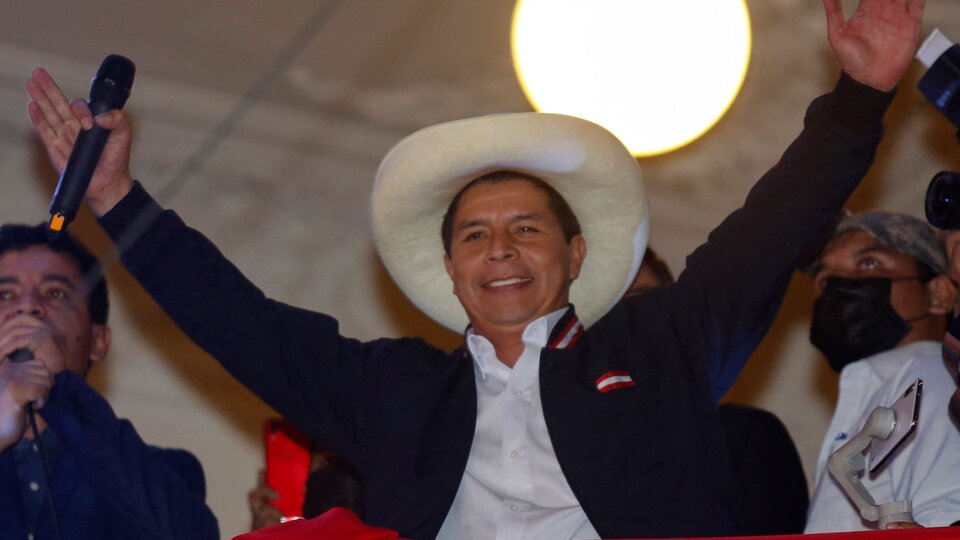
[ad_1]
In the first electoral round, Pedro Castillo was the most voted candidate, but some TV channels did not have his picture. No poll had predicted that this could happen in the second round on June 6. Not only did he do it, but he ended up becoming president.
After the first victory, an image began to circulate around the world: the Peru Libre candidate was walking towards a voting table in a rural area with his wide-brimmed straw hat and mounted on a mare, who had become nervous about it. a crowd.
The question became inevitable: who is Pedro Castillo, the candidate who stormed the Peruvian political scene? Castillo himself seems to want to answer it with the phrase he uses to end his sentences: “The master’s word”. However, in his biography there is a lot of useful information to begin to know the true dimension of his political personality.
Brief history of Castillo’s life
José Pedro Castillo Terrones was born 51 years ago in Chota, a province in the Cajamarca region, one of the most unequal in the country and the largest producer of gold. Chota is also the cradle of the peasant rounds, a model of organization and self-defense adopted by the rural communities of Cajamarca in the mid-1970s and then extended to the rest of the country. The elected president is always defined as a “rondero”.
Castillo started working as a teacher in 1995; At the same time, he obtained a master’s degree in educational psychology and began to gain public notoriety as a leader of the Unitary Union of Education Workers of Peru (SUTEP). In 2002, he ran for mayor of Anguía unsuccessfully for the Peru Posible party; Between 2005 and 2017 he was a member of the Cajamarca committee of this political group, whose main reference was former president Alejandro Toledo, who came to the presidency wrapped in the flags of a soft center-left and ended up adopt all liberal recipes.
However, the most decisive (and political) point in his union career did not come until 2017, when he led the teachers’ strike against President Pedro Pablo Kuczynski (PPK), who was questioned for not having kept an electoral promise to raise wages for the sector.
From that point on, Castillo’s popularity began to grow at the same rate as the fall of Peruvian presidents accused of corruption. Between the departure of the PPK and the current administration of Francisco Sagasti, Martín Vizcarra and Manuel Merino ruled the country. The appearance of Castillo as a political option is an emergence of this upheaval that shook the country.
The campaign that led him to the presidency
On September 30, 2020, the last day for the registration of presidential candidacies, Castillo appeared before the electoral authorities and announced that he would compete for the Peru Free party. The decision to run under the motto of the group led by the mayor of Junín, Vladimir Cerrón, has since brought him many headaches, to the point that he has been repeatedly forced to distance himself from the regional leader.
The two main reasons are the corruption accusations that Cerrón faces and the programmatic definitions of Peru Libre, which is presented as a Marxist and Leninist option. “Do you define yourself as a Marxist?” TV journalist Diego Acuña asked Castillo in mid-May. “No, but we are speaking in a language which is clearly of the people, with a tendency to the left, but a real left, which is progressive and fights for equality,” he explained.
Another controversial front for Castillo is with other sectors of the left and center-left, in particular with Verónika Mendoza’s Juntos por el Perú, who won five parliamentary seats and decided to back him for the second round. Despite this support, the urban and Lima center-left tend to criticize Castillo’s more conservative positions on issues such as abortion or marriage equality. The union of the two forces in a parliamentary coalition, which would add 42 seats, is underway.
Former right-wing candidate Avanza País Hernando de Soto, who won 11.63% of the vote and backed Fujimori in the second round, said Castillo had better “define what he is not, before what it is “. De Soto made the comment after a meeting held after the first round in which the Peru Libre candidate, according to De Soto, clarified that he was not a Communist.
The pandemic in the countryside
The president-elect took a special step during the election campaign. “Castillo has a risky face-to-face campaign in the midst of a pandemic. It is a sacrificial campaign in which he sacrifices himself and catches Covid-19. With this, he connects with a people affected by the pandemic. A sacrificial and risky strategy, very Vietnamese, ”wrote the economist Silvio Rendón at the time.
The panorama Castillo will face is presented as a difficult obstacle course. Besides the opposition of the main media and commercial powers, and Keiko Fujimori’s campaign to delegitimize his triumph, Peru Libre has only 37 of the 130 seats in the Peruvian Congress, who in the last period has shown that he can be relentless in his quest to control the weight of the executive.
.
[ad_2]
Source link
 Naaju Breaking News, Live Updates, Latest Headlines, Viral News, Top Stories, Trending Topics, Videos
Naaju Breaking News, Live Updates, Latest Headlines, Viral News, Top Stories, Trending Topics, Videos